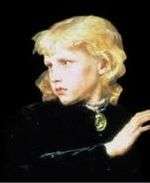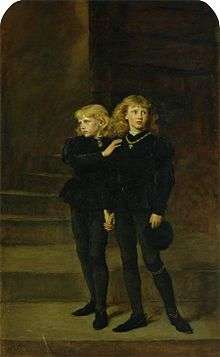Richard of Shrewsbury, Duke of York
| Richard of Shrewsbury | |
|---|---|
| Duke of York; Duke of Norfolk | |
 | |
| Born |
17 August 1473 Shrewsbury, Shropshire |
| Died | Unknown (presumed c.1483, aged 9) |
| Spouse | Anne de Mowbray, 8th Countess of Norfolk |
| House | York |
| Father | Edward IV |
| Mother | Elizabeth Woodville |
Richard of Shrewsbury, Duke of York (born 17 August 1473), was the sixth child and second son of King Edward IV of England and Elizabeth Woodville, born in Shrewsbury. Richard and his older brother, who briefly reigned as King Edward V of England, mysteriously disappeared shortly after Richard III usurped the throne of England in 1483.
Dukedoms
Prince Richard was created Duke of York in May 1474 and made a Knight of the Garter the following year. From this time on, it became a tradition for the second son of the English sovereign to be Duke of York. He was created Earl of Nottingham on 12 June 1476. On 15 January 1478, in St Stephen's Chapel, Westminster, when he was about 4 years old, he married the 5-year-old Anne de Mowbray, 8th Countess of Norfolk, who had inherited the vast Mowbray estates in 1476. Because York's father's-in-law dukedom had become extinct when Anne could not inherit it, he was created Duke of Norfolk and Earl Warenne on 7 February 1477.When Anne de Mowbray died in November 1481 her estates should have passed to William, Viscount Berkeley and to John, Lord Howard. In January 1483 Parliament passed an act that gave the Mowbray estates to Richard, Duke of York and Norfolk, for his lifetime, and at his death to his heirs, if he had any. The rights of the two co-heirs at law were extinguished; Viscount Berkeley had financial difficulties and King Edward IV paid off those debts. Berkeley then renounced his claims to the Mowbray estate before parliament in 1483. Nothing was done for Lord Howard.
Heir presumptive

His father died on 9 April 1483. Thus his brother Edward, Prince of Wales, became King of England and was acclaimed as such, and Richard his Heir Presumptive. This was not to last. A priest, now generally believed to have been Robert Stillington, the Bishop of Bath and Wells, testified that Edward IV had agreed to marry Lady Eleanor Talbot in 1461.[1] Lady Eleanor was still alive when Edward married Elizabeth Woodville in 1464. The Regency council under the late King's brother Richard Duke of Gloucester, concluded that this was a case of bigamy, invalidating the second marriage and the legitimacy of all children of Edward IV by this marriage. Under Gloucester's influence, both Edward and Richard were declared illegitimate and removed from the line of succession on 25 June 1483. The Duke of Gloucester, as the only surviving brother of Edward IV, became King Richard III.

Possible fate
The Duke of York was sent to the Tower of London, then a royal residence, by King Richard III in mid-1483, where he was held with his brother. They were sometimes seen in the garden of the Tower, but there are no known sightings of them after the summer of 1483. What happened to the two of them—the Princes in the Tower—after their disappearance remains unknown. Tudor History was quick to blame his uncle, Richard.[2] Thomas More wrote that the princes were smothered to death with their pillows, and his account forms the basis of William Shakespeare's play Richard III, in which Tyrrell suborns Forrest and Dighton to murder the princes on Richard's orders. Subsequent re-evaluations of Richard III have questioned his guilt, beginning with William Cornwallis early in the 17th century.[3] In the period before the boys' disappearance, Edward was regularly being visited by a doctor; historian David Baldwin extrapolates that contemporaries may have believed Edward had died either of an illness (or as the result of attempts to cure him).[4] In the absence of hard evidence a number of other theories have been put forward, of which the most widely discussed are that they were murdered on the orders of the Duke of Buckingham or by Henry Tudor.
Bones reportedly belonging to two children were discovered in 1674 by workmen rebuilding a stairway in the Tower. On the orders of King Charles II, these were subsequently placed in Westminster Abbey, in an urn bearing the names of Edward and Richard.[5] The bones were re-examined in 1933 at which time it was discovered the skeletons were incomplete and had been interred with animal bones. It has never been proven that the bones belonged to the princes.[6]
In 1789, workmen carrying out repairs in St George's Chapel, Windsor, rediscovered and accidentally broke into the vault of Edward IV and Elizabeth Woodville. Adjoining this was another vault, which was found to contain the coffins of two children. This tomb was inscribed with the names of two of Edward IV's children: George, Duke of Bedford, who had died at the age of 2; and Mary of York who had died at the age of 14. Both had predeceased the King. However, the remains of these two children were later found elsewhere in the chapel, leaving the occupants of the children's coffins within the tomb unknown.[7]
In 1486 Richard's sister Elizabeth married Henry VII, thereby uniting the Houses of York and Lancaster.[8]
Arms

As son of the king, Richard was granted use of the arms of the kingdom, differentiated by a label argent, on the first point a canton gules.[9]
In popular culture
The comedy series The Black Adder features an alternative history where Richard succeeded his uncle King Richard III to the throne as King Richard IV of England (portrayed by Brian Blessed).
Richard appears in Philippa Gregory's 2009 fictionalized novel The White Queen, which follows the theory that Richard's mother, Elizabeth Woodville, never gave young Richard over to the custody of his uncle, instead swapping him with a changeling and sending the true prince into hiding in Tournai, Belgium. He appears later in the novel under the assumed name, Perkin Warbeck. The escape plot also is repeated in the 2013 television adaptation The White Queen, with Richard returning to his mother at the end of the series.
Richard is a character in the young adult series of novels, The Missing, by Margaret Peterson Haddix. He appears in the second book, Sent, as the character Alex Polchak.
Richard appears in the Japanese anime Kuroshitsuji as a small boy, who, together with his older brother, Edward V, haunts Ludlow Castle, until they can both find salvation and be sent to Heaven. Edward believes that, to do that, he must gather the skulls of his whole family but cannot, since, for some reason, which is revealed later, Richard refuses to hand over what is presumed to be his own. He is voiced by Sasamoto Yuuko in the original and by Maxey Whitehead in the English dub.
In Vanora Bennett's historical novel Portrait of an Unknown Woman, Richard is depicted as a grown man, John Clement, a member of Thomas More's household, and husband to his adopted daughter Meg Giggs.
The story of the Princes in the Tower and a version of their subsequent fates is included in the novel The Master of Bruges by Terence Morgan.
Ancestry
References
- ↑ Peter Hancock, Richard III and the Murder in the Tower (History Press, 2011), ISBN 0752457977
- ↑ Horrox, Rosemary. "Edward V of England". Oxford Dictionary of National Biography. Oxford University Press. Retrieved 25 August 2013. (subscription required)
- ↑ Kendall, P.M., Richard III, Aylesbury 1972, p.427; in the Encomium of Richard III, dedicated to Sir John Donne.
- ↑ Baldwin, David (2013) "The White Queen - What happened to the Princes in the Tower?", BBC History
- ↑ John Steane, The Archaeology of the Medieval English Monarchy (Routledge, 1993), page 65
- ↑ Weir, Alison. The Princes in the Tower. 1992, Random House, ISBN 9780345391780
- ↑ 1..Chapter Records XXIII to XXVI, The Chapter Library, St. George's Chapel, Windsor (Permission required) 2..William St. John Hope: "Windsor Castle: An Architectural History", pages 418–419. (1913). 3..Vetusta Monumenta, Volume III, page 4 (1789).
- ↑ 1.Chapter Records XXIII to XXVI, The Chapter Library, St. George's Chapel, Windsor (Permission required) 2.William St. John Hope: "Windsor Castle: An Architectural History", pages 418-419. (1913). 3.Vetusta Monumenta, Volume III, page 4 (1789).
- ↑ Marks of Cadency in the British Royal Family
- Ashley, Mike (2002). British Kings & Queens. Carroll & Graf. ISBN 0-7867-1104-3. page 218
- Weir, Alison (1995). The Princes in the Tower. Ballantine Books. ISBN 0-345-39178-0.
- Ross, Charles (1974). Edward IV. University of California Press. ISBN 0-520-02781-7. page 248
External links
| Wikimedia Commons has media related to Richard of Shrewsbury, 1st Duke of York. |
| Richard of Shrewsbury, Duke of York and Norfolk Cadet branch of the House of Plantagenet Born: 17 August 1473 Died: 1483? | ||
| Political offices | ||
|---|---|---|
| Preceded by The Countess of Norfolk |
Earl Marshal with Anne until 1481; Sir Thomas Grey acting as deputy 1478–1483 |
Succeeded by The Duke of Norfolk |
| Peerage of England | ||
| New creation | Duke of York 2nd creation 1474–1483 |
Extinct |
| Earl of Nottingham 3rd creation 1476–1483 | ||
| Duke of Norfolk, Earl of Warenne 3rd creation 1477–1483 | ||